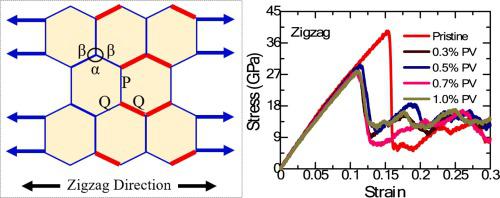Computational Materials Science ( IF 3.3 ) Pub Date : 2021-08-29 , DOI: 10.1016/j.commatsci.2021.110824 A.S.M. Jannatul Islam 1 , Md. Sayed Hasan 1 , Md. Sherajul Islam 1, 2 , Jeongwon Park 2, 3

|
Structural reliability is one of the most fundamental disquiets for realizing future nanoelectromechanical systems (NEMS). Of late, atomically thin two-dimensional zinc sulfide (2D-ZnS) shows great potential for advanced NEMS and a substitute to graphene and transition metal di-chalcogenides because of its exceptional optical and electronic properties. Here, we systematically explore the impacts of temperature (100–700 K) and vacancy defects (bi and point vacancies) with a concentration of 0.3%–1.0% on the tensile mechanical behavior such as fracture strength, elastic modulus as well as fracture strain of 2D-ZnS through molecular dynamics simulation. To expose the fracture mechanism quantitatively, the rupturing phenomenon at different temperature and vacancy concentrations for bi vacancy and point vacancy defects is also explored. The mechanical behavior with different sheet area and loading rate are also exposed. At room temperature, fracture stress of ~40.94 GPa and an elastic modulus of ~313.66 GPa along the armchair direction were determined, which is about ~3.65% and ~2.75% greater than the zigzag oriented fracture strength and elastic modulus, respectively. The point vacancy makes the mechanical strength decline more rapidly than the bi vacancy because of its more significant regularity breakdown effect. We also find that 2D-ZnS is less sensitive to sheet area and strain rate compared to temperature and vacancy defects. The in-depth analysis on mechanical properties explored here would be beneficial in controlling the tensile mechanical behavior of 2D-ZnS for its applications in next-generation NEMS and nanodevices.
中文翻译:

手性、温度和空位对单层硫化锌力学行为的影响
结构可靠性是实现未来纳米机电系统 (NEMS) 的最基本问题之一。最近,原子级薄的二维硫化锌 (2D-ZnS) 由于其卓越的光学和电子特性,在先进的 NEMS 和石墨烯和过渡金属二硫属化物的替代品方面显示出巨大的潜力。在这里,我们系统地探索了温度(100-700 K)和浓度为 0.3%-1.0% 的空位缺陷(双空位和点空位)对拉伸力学行为(如断裂强度、弹性模量和断裂应变)的影响2D-ZnS 通过分子动力学模拟。为了定量揭示断裂机制,还探讨了双空位和点空位缺陷在不同温度和空位浓度下的断裂现象。还暴露了具有不同片材面积和加载速率的力学行为。在室温下,确定了~40.94 GPa 的断裂应力和~313.66 GPa 沿扶手椅方向的弹性模量,分别比之字形取向断裂强度和弹性模量大~3.65% 和~2.75%。点空位由于其规律性击穿效应更显着,使得机械强度比双空位下降得更快。我们还发现,与温度和空位缺陷相比,2D-ZnS 对片材面积和应变率的敏感性较低。此处探索的对机械性能的深入分析将有利于控制 2D-ZnS 的拉伸机械行为,以使其在下一代 NEMS 和纳米器件中的应用。


























 京公网安备 11010802027423号
京公网安备 11010802027423号